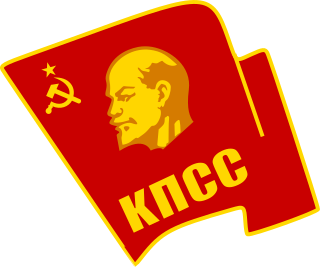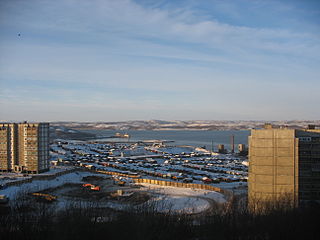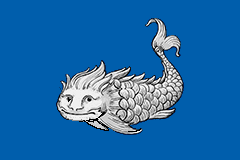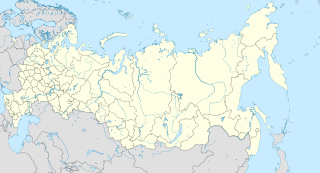Saamsky District (Russian : Саамский район) was an administrative division (a district) of Murmansk Okrug of Leningrad Oblast, and later of Murmansk Oblast, of the Russian SFSR, Soviet Union, which existed in 1927–1963.

Russian is an East Slavic language, which is official in the Russian Federation, Belarus, Kazakhstan and Kyrgyzstan, as well as being widely used throughout Eastern Europe, the Baltic states, the Caucasus and Central Asia. It was the de facto language of the Soviet Union until its dissolution on 25 December 1991. Although, nowadays, over two decades after the breakup of the Soviet Union, Russian is used in official capacity or in public life in all the post-Soviet nation-states, as well as in Israel and Mongolia, the rise of state-specific varieties of this language tends to be strongly denied in Russia, in line with the Russian World ideology.
A raion is a type of administrative unit of several post-Soviet states. The term is from the French "rayon", which is both a type of a subnational entity and a division of a city, and is commonly translated in English as "district".
Murmansk Okrug was an administrative division of the Russian SFSR, Soviet Union, which existed in 1927–1938.
Contents
It was established as Ponoysky District (Понойский район) on August 1, 1927, when the All-Russian Central Executive Committee issued two Resolutions: "On the Establishment of Leningrad Oblast" and "On the Borders and Composition of the Okrugs of Leningrad Oblast". [1] According to these resolutions, Murmansk Governorate was transformed into Murmansk Okrug, which was divided into six districts (Ponoysky being one of them) and included into Leningrad Oblast. [1] The administrative center of the district was in the selo of Ponoy. [1]

The All-Russian Central Executive Committee, was the highest legislative, administrative, and revising body of the Russian Soviet Federative Socialist Republic from 1917 until 1937. Although the All-Russian Congress of Soviets had supreme authority, in periods between its sessions its powers were passed to VTsIK.
Murmansk Governorate was an administrative division of the early Russian SFSR which existed in 1921–1927. The governorate was established on the territory of former Alexandrovsky Uyezd of Arkhangelsk Governorate by the All-Russian Central Executive Committee (VTsIK) Decree issued on June 13, 1921. The administrative center was in Murmansk.

Leningrad Oblast is a federal subject of Russia. It was established on August 1, 1927, although it was not until 1946 that the oblast's borders had been mostly settled in their present position. The oblast was named after the city of Leningrad. Unlike the city, the oblast retains the name of Leningrad.
In 1934, the Murmansk Okrug Executive Committee developed a redistricting proposal, which was approved by the Resolution of the 4th Plenary Session of the Murmansk Okrug Committee of the VKP(b) on December 28-29, 1934 and by the Resolution of the Presidium of the Murmansk Okrug Executive Committee on February 2, 1935. [2] On February 15, 1935, the VTsIK approved the redistricting of the okrug into seven districts, although it did not specify what territories the new districts were to include. [2] On February 26, 1935, the Presidium of the Leningrad Oblast Executive Committee worked out the details of the new district scheme and issued a resolution, which, among other things, renamed the district Saamsky and moved its administrative center to Iokanga. [2] Additionally, Chalmny-Varrsky and Semiostrovsky Selsoviets of Lovozersky District, as well as the settlement of Drozdovka of Teribersky District, were transferred to Saamsky District. [2] On June 1, 1936, the renaming of the district and the administrative center move were approved by the Resolution of the VTsIK. [2]

The Communist Party of the Soviet Union (CPSU) was the founding and ruling political party of the Soviet Union. The CPSU was the sole governing party of the Soviet Union until 1990, when the Congress of People's Deputies modified Article 6 of the most recent 1977 Soviet constitution, which had granted the CPSU a monopoly over the political system.

Lovozersky District is an administrative district (raion), one of the six in Murmansk Oblast, Russia. Municipally, it is incorporated as Lovozersky Municipal District. It occupies most of the central and northeastern parts of the Kola Peninsula. The area of the district is 53,800 square kilometers (20,800 sq mi). Its administrative center is the rural locality of Lovozero. District's population: 11,820 (2010 Census); 14,311 (2002 Census); 18,263 (1989 Census). The population of Lovozero accounts for 24.3% of the district's total population.
Drozdovka is the name of several rural localities in Russia.
Iokanga, the administrative center of the district at the time, comprised de facto two separate inhabited localities, located within 12 kilometers (7.5 mi) from one another—Iokanga proper and Iokangskaya baza, with the district executive committee quarters being located in the latter. [2] In 1936, Iokangskaya baza was renamed Gremikha, but Iokanga continued to be listed as the administrative center of Saamsky District until February 1938. [2]

Ostrovnoy, previously known as Murmansk-140 (Му́рманск-140), is a closed town in Murmansk Oblast, Russia. As of the 2010 Census, its population was 2,171; down from 5,032 recorded in the 2002 Census.
Chalmny-Varrsky selsoviet did not remain in Saamsky District for long—the VTsIK Resolution of September 10, 1937 transferred it back to Lovozersky District. [2]
Saamsky District was abolished on January 26, 1963 by the Decision of the Murmansk Oblast Executive Committee. [3] The district's selsoviets were transferred to Lovozersky District, while Gremikha, the administrative center of the former district, was subordinated to Severomorsk. [3]

Severomorsk, previously known as Vayenga (Ваенга), is a closed town in Murmansk Oblast, Russia. Severomorsk is the main administrative base of the Russian Northern Fleet. The town is located on the coast of the Barents Sea along the Kola Bay 25 kilometers (16 mi) northeast of Murmansk, the administrative centre of the oblast, to which it is connected by railway and a motorway.







